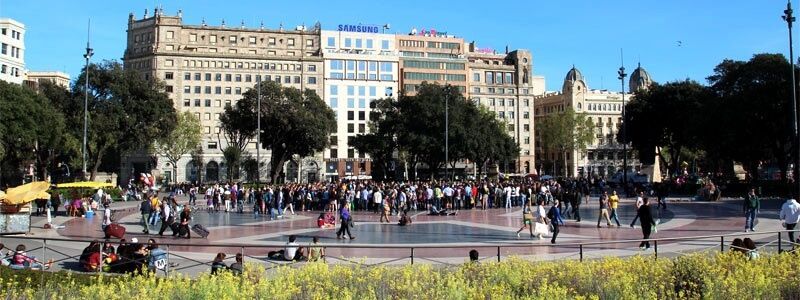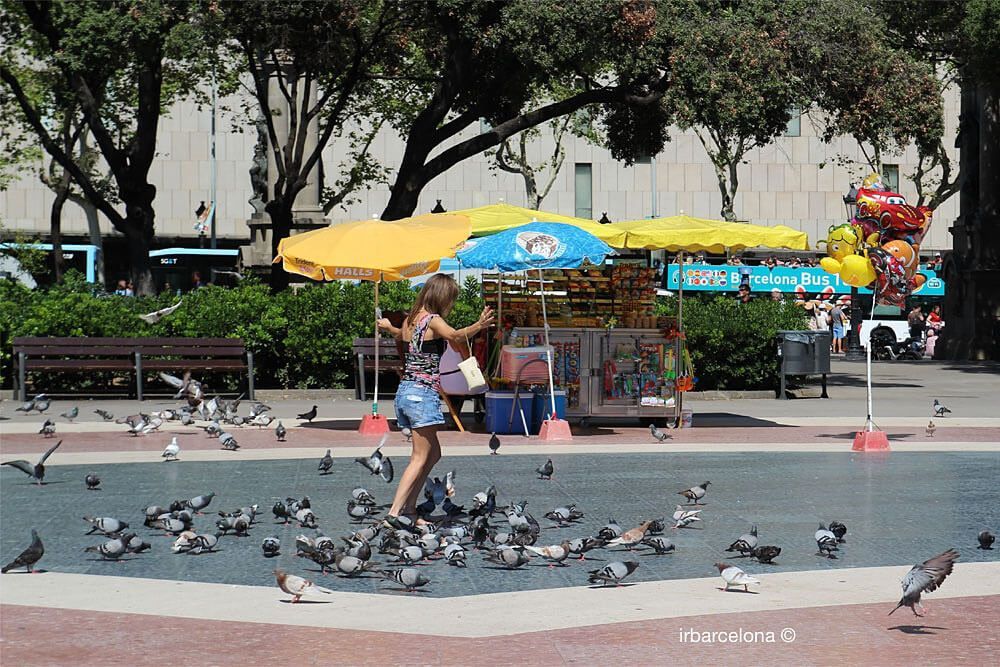
Updated Jun 01 2023
The Plaça de Catalunya in Barcelona (in English Catalonia Square) is right in the heart of the city of Barcelona, and could be seen as the equivalent of the ‘0 km’ of the Plaza del Sol in Madrid. We could stick our neck out and say, without fear of being wrong, that there’s not a tourist who comes to Barcelona who doesn’t pass through the more famous square in Barcelona.
When you arrive in Barcelona you would be wise to use the Plaça de Catalunya as a point of reference in order to orientate yourself, especially as it brings together two of the most important and busiest streets of the city, the Passeig de Gràcia and the world-famous La Rambla, streets you’ll also get to know well.

What to know about the Catalonia Square
There are many aspects of Barcelona’s most well-known square that make it so recognizable, from its history to what it represents today – a central meeting point, a hub for public transport and even a popular sites for demonstrations and protests.
In the middle of the 19th century the space was the site of the demolition of many of the city’s walls, by which time it was already known as the Plaça de Catalunya.
Over time some houses were built, but when the local council made the decision to turn the area into a huge square that would become the heart of the city’s activity, they bought all the land, in addition to the buildings which were there at the time.
Following many years of construction work, and much deviation from the original plans, the square was eventually inaugurated by King Alfonso XIII in 1927.
The Catalonia Square Today
The Plaça de Catalunya is now one of the busiest parts of the city, a square that everyone visits and a favourite spot for tourists to take photos, with the iconic backdrop of one of the two monumental fountains that the square boasts.
Standing in the centre of the square, in which is (printed on the floor) a huge compass rose, you will be able to get a great view of the many characteristic buildings that surround you. The most well-known are the department store El Corte Inglés, the building that used to be the headquarters of the Central Bank of Barcelona, which is well-known for the bank raid which took place in 1981, and most recently the new Apple Store, which is just off the square on the corner of the Passeig de Gràcia.

Having told you about the iconic buildings, fountains and sculptures, it’s ironic that some of the most memorable features of the Plaça de Catalunya are the huge number of pigeons in the centre of the square. If you don’t like birds, you might not feel entirely comfortable there!
It’s not surprising that they generally centre around the stalls where bird food is sold, so avoid these areas if you’re not a fan of pigeons. However, if you do like them, you can buy seeds to feed the pigeons, and take a photo of them flocking towards you as you hold out the bird seed – a photo which is very typical of those taken by the tourists who visit the square.
The Pigeons
If you would like to enjoy views of the Plaça de Catalunya from a different perspective, our recommendation is to go up to the café on the top floor of El Corte Inglés, that you’ll find on one side of the square. From there you will enjoy a wonderful panoramic view of the square and surrounding areas, which is even more spectacular at sunset.

Monuments and Sculptures
We don’t need to tell you to look out for the fountains in the Plaça de Catalunya, as they are the first things you’ll see as you enter the square, but we will tell you about some of the monuments and sculptures, as the square is so big that many of them can go unnoticed if you’re not looking out for them. Here is a list of the sculptures you’ll find:la Deessa (The Goddess), by Josep Clarà
El Pastor (The Shepherd), by Pablo Gargallo
Monument dedicated to Francesc Macià, by Josep Maria Subirachs
El Forjador (The Peacemaker), by Josep Llimona
Una figura femenina (A Feminine Figure), by Enrique Casanovas
By day and by night
As with in many of Barcelona’s squares and streets, the atmosphere in the Plaça de Catalunya changes according to the time of day (especially during the Christmas holidays), so you will get a very different experience depending on when you visit during the day or in the evening. If you can spare the time, we would therefore recommend that you fit in a couple of visits at contrasting times of the day – and don’t forget your camera!
Photo gallery
Map
Address
Plaça de Catalunya, Barcelona.
How to get there
Metro: Catalunya (lines 1 and 3).
FGC and RENFE: Catalunya
Buses: lines 24, 41, 42, 55, 59, 66, 91, H16, V13, V15 and Barcelona tourist bus.
Nearby places of interest
Gran Teatre del Liceu
Plaça de la Universitat (University Square)
La Rambla of Barcelona
Passeig de Gràcia
Fountain of Canaletes

 Tickets Online
Tickets Online Travel cards
Travel cards






